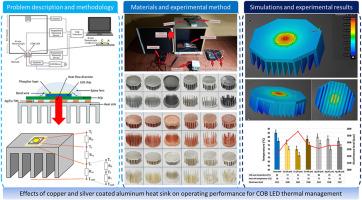镀铜和镀银铝散热器对COB LED热管理工作性能的影响
IF 4.6
3区 工程技术
Q2 ENGINEERING, ELECTRICAL & ELECTRONIC
引用次数: 0
摘要
片上发光二极管(COB LED)将吸收的大部分能量转换为热量,从而导致LED芯片的温度升高。各种主动和被动冷却系统已经被开发来解决热管理问题。本研究在实际应用中,分析了不同类型及不同镀铜或镀银厚度的散热片对COB LED工作性能的影响。在6种不同尺寸的Etial 150和6063铝合金散热器上分别涂覆10、25和40 μm厚度的电解涂层,计算出66种不同COB led散热器组合的最适宜涂层厚度。两种不同的理论计算结果、ANSYS仿真程序进行的热分析结果和实验应用结果完全一致,总体上确定了镀铜散热器的最佳厚度为25 μm,镀银散热器的最佳厚度为10 μm。结果表明,不同的涂层厚度降低了总热阻值和结温,提高了光照度。此外,还研究了COB led -散热器组合的涂层成本、基于最佳涂层厚度的相关性分析以及几何参数对散热器传热和性能的影响。考虑到理想的涂层厚度对COB led的寿命、性能、可靠性和效率的影响,根据本研究的分析结果,可以推荐COB作为散热应用中现有商用散热片的替代品。本文章由计算机程序翻译,如有差异,请以英文原文为准。

Effects of copper and silver coated aluminum heat sink on operating performance for COB LED thermal management
The chip-on-board light-emitting diodes (COB LEDs) convert most of the energy drawn into heat, which causes a temperature increase in the LED chips. Various active and passive cooling systems have been developed to solve thermal management problems. In this study, the effects of different types and heat transfer coefficients of heat sinks deposited with different thicknesses of copper or silver coating on COB LED operating performance were analyzed in practice. Electrolytic coatings of 10, 25 and 40 μm thickness were applied to 6 heat sinks of different sizes made of Etial 150 and 6063 aluminum alloys, and the most suitable coating thickness was calculated for 66 different COB LED-heat sink combinations. The results of two different theoretical calculations, thermal analysis performed with the ANSYS simulation program and experimental application are fully compatible with each other and in general, the optimum thickness was determined as 25 μm for copper-coated heat sinks and 10 μm for silver-coated heat sinks. It was observed that different coating thicknesses reduce the total thermal resistance value and the junction temperature and increase the illuminance level. Furthermore, coating costs, correlation analysis based on optimum coating thickness in COB LED-heat sink combinations, and the effects of geometric parameters on heat transfer and performance of heat sinks are also investigated. Considering the effects of ideal coating thickness on the lifetime, performance, reliability and efficiency of COB LEDs, it can be recommended as an alternative to existing commercial heat sinks in heat spreading applications based on the analysis results in the present study.
求助全文
通过发布文献求助,成功后即可免费获取论文全文。
去求助
来源期刊

Materials Science in Semiconductor Processing
工程技术-材料科学:综合
CiteScore
8.00
自引率
4.90%
发文量
780
审稿时长
42 days
期刊介绍:
Materials Science in Semiconductor Processing provides a unique forum for the discussion of novel processing, applications and theoretical studies of functional materials and devices for (opto)electronics, sensors, detectors, biotechnology and green energy.
Each issue will aim to provide a snapshot of current insights, new achievements, breakthroughs and future trends in such diverse fields as microelectronics, energy conversion and storage, communications, biotechnology, (photo)catalysis, nano- and thin-film technology, hybrid and composite materials, chemical processing, vapor-phase deposition, device fabrication, and modelling, which are the backbone of advanced semiconductor processing and applications.
Coverage will include: advanced lithography for submicron devices; etching and related topics; ion implantation; damage evolution and related issues; plasma and thermal CVD; rapid thermal processing; advanced metallization and interconnect schemes; thin dielectric layers, oxidation; sol-gel processing; chemical bath and (electro)chemical deposition; compound semiconductor processing; new non-oxide materials and their applications; (macro)molecular and hybrid materials; molecular dynamics, ab-initio methods, Monte Carlo, etc.; new materials and processes for discrete and integrated circuits; magnetic materials and spintronics; heterostructures and quantum devices; engineering of the electrical and optical properties of semiconductors; crystal growth mechanisms; reliability, defect density, intrinsic impurities and defects.
 求助内容:
求助内容: 应助结果提醒方式:
应助结果提醒方式:


